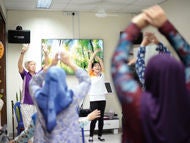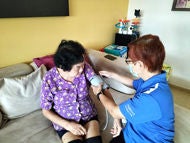What is - Concussion
Concussion is a type of brain injury that typically occurs after a sudden bump, blow, or jolt to the head, face, or neck and causes the brain not to work normally. These injuries can cause damage to the brain and need to be assessed urgently.
Concussion commonly occurs during sports or accidental falls. It may or may not involve loss of consciousness.
Symptoms of Concussion
If one or more of the following symptoms are present, please seek medical attention immediately.
- Headache
- Memory loss
- Persistent difficulty in concentrating
- Feeling sluggish, hazy, or slower in thinking
- Emotional changes such as feeling irritable, sad, nervous, or more emotional than usual
- Nausea, vomiting, dizziness, and balance issues
- Blurry or double vision
- Sensitivity to light or noise
- Sleep disturbance
Concussion - How to prevent
The most common cause of concussions in children and teenagers is head injury during contact sports such as rugby, football, and basketball, as well as non-contact sports such as cricket and softball.
While participating in sports is a great way for your child to make friends and stay active, here are some things you can do to ensure they stay safe while they play:
- Encourage your child to learn proper sports techniques from their coaches. These techniques will promote safe play and ensure safety in situations where contact occurs.
- Encourage your child to follow his or her coach’s safety instructions and the rules of their sport.
- Encourage children (and their coaches) to report any head injuries, even if it means that they have to sit out of the game for some time.
- Where relevant, encourage your child to wear safety equipment (e.g. helmets) that are recommended for the sport. Protective gear must also fit well and be used properly.
Concussions can also occur from falls at home (e.g. from a double-decker bed). Home fittings and furniture should be assessed for safety.
Diagnosis of Concussion
The diagnosis of concussion is made by the doctor after being informed about the symptoms during and after the injury, as well as after a physical examination of the injured child.
Treatment for Concussion
Adequate rest.
It is important that your child avoids intense or long durations of reading, watching television, and using the phone or laptop. Talk to your child regularly and make sure they are not doing anything that makes their symptoms worse.
Timely return to school.
After the recommended rest by the doctor, your child can return to school. To ensure your child is ready to return to school, make sure your child can focus for the duration of a class period without causing symptoms to return.
Once your child is back in school, continue to talk to your child regularly and ask how they are tolerating school work. If they are unable to cope, you may wish to speak with the school administration about making any of the following adjustments:
- Limiting your child’s course load
- Shortening your child’s school day
- Increasing rest time between classes
Gradual return to sport.
Once your child has fully returned to school, they should begin a gradual return to full contact sports. If your child incurs a second head injury before he or she fully recovers from concussion, it can result in a more serious injury.
The child should follow this five stage plan:
| Stage 1: | Walking or stationary cycling at a slow or medium pace without any resistance |
| Stage 2: | Running drills without head impact |
| Stage 3: | More difficult, non-contact drills such as passing or shooting drills. May also resume resistance training. |
| Stage 4: | Full contact practice with close monitoring |
| Stage 5: | Return to normal play |
Your child should not have any symptoms after each stage for at least a week before moving on to the next stage. Do not rush to the next stage if your child is not ready. If any symptom recurs, rest until the symptom resolves. The child may need to return to an earlier stage and scale up slowly again.
Studies have shown that a gradual return to play ensures a faster recovery for your child. They will be much safer when they return back to full contact play. If you would like any advice on how to carry this plan out, please approach your doctor or nurse for more information.
If your child has persistent complaints of headache, difficulty concentration, drowsiness or change in behaviour, please bring your child back to the Emergency Department.
Your child may be given follow-up to see Physiotherapist and Concussion clinic. It is important to attend the appointments. During the appointment, the following will be done:
- Screening of symptoms
- Functional assessment
- Education on concussion and related complication
- Advice for return to physical activity
- Home exercise program (if needed)
Contributed by
The information provided is not intended as medical advice. Terms of use. Information provided by SingHealth.
Get to know our doctors at SingHealth Hospitals in Singapore.
Get to know our doctors at SingHealth Hospitals in Singapore. here.




















